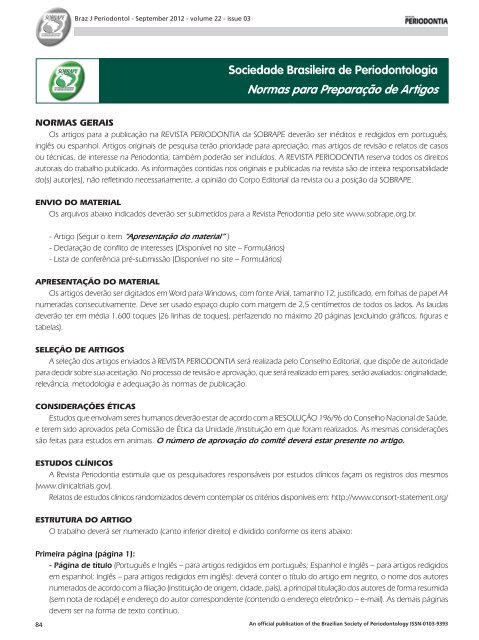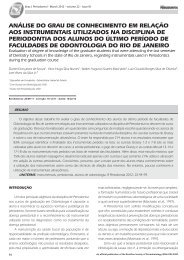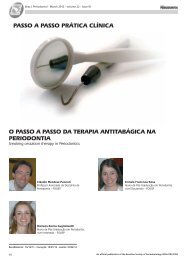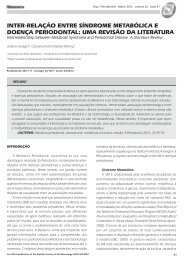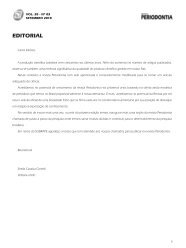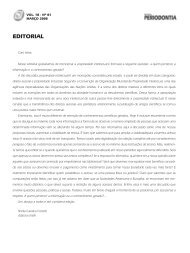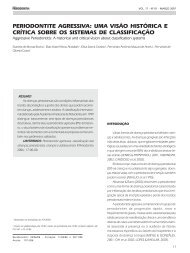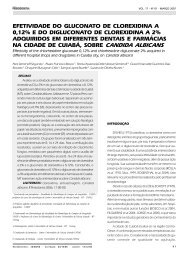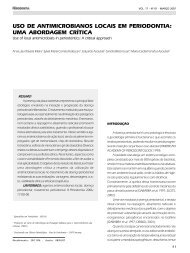Revista Periodontia Setembro 2012.indd - Revista Sobrape
Revista Periodontia Setembro 2012.indd - Revista Sobrape
Revista Periodontia Setembro 2012.indd - Revista Sobrape
Create successful ePaper yourself
Turn your PDF publications into a flip-book with our unique Google optimized e-Paper software.
Braz J Periodontol - September 2012 - volume 22 - issue 03<br />
Sociedade Brasileira de Periodontologia<br />
Normas para Preparação de Artigos<br />
Normas gerais<br />
Os artigos para a publicação na REVISTA PERIODONTIA da SOBRAPE deverão ser inéditos e redigidos em português,<br />
inglês ou espanhol. Artigos originais de pesquisa terão prioridade para apreciação, mas artigos de revisão e relatos de casos<br />
ou técnicas, de interesse na <strong>Periodontia</strong>, também poderão ser incluídos. A REVISTA PERIODONTIA reserva todos os direitos<br />
autorais do trabalho publicado. As informações contidas nos originais e publicadas na revista são de inteira responsabilidade<br />
do(s) autor(es), não refletindo necessariamente, a opinião do Corpo Editorial da revista ou a posição da SOBRAPE.<br />
Envio do Material<br />
Os arquivos abaixo indicados deverão ser submetidos para a <strong>Revista</strong> <strong>Periodontia</strong> pelo site www.sobrape.org.br.<br />
- Artigo (Seguir o item “Apresentação do material” )<br />
- Declaração de conflito de interesses (Disponível no site – Formulários)<br />
- Lista de conferência pré-submissão (Disponível no site – Formulários)<br />
Apresentação do material<br />
Os artigos deverão ser digitados em Word para Windows, com fonte Arial, tamanho 12, justificado, em folhas de papel A4<br />
numeradas consecutivamente. Deve ser usado espaço duplo com margem de 2,5 centímetros de todos os lados. As laudas<br />
deverão ter em média 1.600 toques (26 linhas de toques), perfazendo no máximo 20 páginas (excluindo gráficos, figuras e<br />
tabelas).<br />
Seleção de artigos<br />
A seleção dos artigos enviados à REVISTA PERIODONTIA será realizada pelo Conselho Editorial, que dispõe de autoridade<br />
para decidir sobre sua aceitação. No processo de revisão e aprovação, que será realizado em pares, serão avaliados: originalidade,<br />
relevância, metodologia e adequação às normas de publicação.<br />
Considerações Éticas<br />
Estudos que envolvam seres humanos deverão estar de acordo com a RESOLUÇÃO 196/96 do Conselho Nacional de Saúde,<br />
e terem sido aprovados pela Comissão de Ética da Unidade /Instituição em que foram realizados. As mesmas considerações<br />
são feitas para estudos em animais. O número de aprovação do comitê deverá estar presente no artigo.<br />
Estudos clínicos<br />
A <strong>Revista</strong> <strong>Periodontia</strong> estimula que os pesquisadores responsáveis por estudos clínicos façam os registros dos mesmos<br />
(www.clinicaltrials.gov).<br />
Relatos de estudos clínicos randomizados devem contemplar os critérios disponíveis em: http://www.consort-statement.org/<br />
Estrutura do artigo<br />
O trabalho deverá ser numerado (canto inferior direito) e dividido conforme os itens abaixo:<br />
Primeira página (página 1):<br />
- Página de título (Português e Inglês – para artigos redigidos em português; Espanhol e Inglês – para artigos redigidos<br />
em espanhol; Inglês – para artigos redigidos em inglês): deverá conter o título do artigo em negrito, o nome dos autores<br />
numerados de acordo com a filiação (instituição de origem, cidade, país), a principal titulação dos autores de forma resumida<br />
(sem nota de rodapé) e endereço do autor correspondente (contendo o endereço eletrônico – e-mail). As demais páginas<br />
devem ser na forma de texto contínuo.<br />
84 An official publication of the Brazilian Society of Periodontology ISSN-0103-9393
Braz J Periodontol - September 2012 - volume 22 - issue 03<br />
Exemplo:<br />
Associação do PDGF e IGF na Regeneração Periodontal – Revisão de Literatura<br />
Fernando Hayashi 1 , Fernando Peixoto 1 , Chistiane Watanabe Yorioka 1 , Francisco Emílio Pustiglioni 2<br />
1<br />
Mestrandos em <strong>Periodontia</strong> da FOUSP<br />
2<br />
Professor titular de <strong>Periodontia</strong> da FOUSP<br />
Segunda página (página 2):<br />
- Resumo: deve fornecer uma visão concisa e objetiva do trabalho, incluindo objetivos, material e métodos, resultados e<br />
as conclusões. Deve conter no máximo 250 palavras (incluindo pontos, vírgulas etc).<br />
- Palavras-chave: são palavras ou expressões que identificam o conteúdo do texto. Para sua escolha, deverá ser consultada<br />
a lista “Descritores em Ciências de Saúde – DECS”, da BIREME. Número de palavras-chave: máximo 6.<br />
OBS: Para artigos redigidos em língua estrangeira, Espanhol ou Inglês, o item Resumo não configura item obrigatório.<br />
Terceira página (página 3):<br />
- Abstract e Keywords: cópia precisa e adequada do resumo e palavras-chave em Inglês. Deverá ser consultada a lista<br />
“Medical subject headings”. Disponível em www.nlm.nih.gov/mesh/MBrowser.html. Número de Keywords: máximo 6.<br />
- Sugere-se para autores não-nativos que procurem assistência com a sua escrita utilizando instituições especializadas<br />
como American Journal Experts (http://www.journalexperts.com)<br />
Quarta e demais páginas (página 4 e demais):<br />
- Introdução: é o sumário dos objetivos do estudo, de forma concisa, citando as referências mais pertinentes. Também<br />
deve apresentar as hipóteses em estudo e a justificativa do trabalho.<br />
- Material e Métodos: devem ser apresentados com suficientes detalhes que permitam confirmação das observações<br />
encontradas, indicando os testes estatísticos utilizados.<br />
- Resultados: as informações importantes do trabalho devem ser enfatizadas e apresentadas em sequência lógica no<br />
texto, nas figuras e tabelas, citando os testes estatísticos. As tabelas e figuras devem ser numeradas (algarismo arábico)<br />
e citadas durante a descrição do texto. Cada tabela deve conter sua respectiva legenda, citada acima, em espaço duplo,<br />
em página separada, no final do artigo depois das referências. As figuras também devem estar localizadas em páginas<br />
separadas, no final do texto, porém, as legendas devem estar localizadas a baixo.<br />
- Discussão: os resultados devem ser comparados com outros trabalhos descritos na literatura, onde também podem<br />
ser feitas as considerações finais do trabalho.<br />
- Conclusão: deve responder: objetivamente aos questionamentos propostos.<br />
- Agradecimentos (quando houver): a assistências técnicas, laboratórios, empresas e colegas participantes.<br />
- Referências Bibliográficas: Essa seção será elaborada de acordo com as Normas Vancouver (disponíveis em: www.<br />
icmje.org), devendo ser numeradas sequencialmente conforme aparição no texto. E, as abreviações das revistas devem<br />
estar em conformidade com o Index Medicus/ MEDLINE.<br />
Todos os autores da obra devem ser mencionados.<br />
Exemplos – Normas Vancouver:<br />
Artigo de <strong>Revista</strong>:<br />
1. Lima RC, Escobar M, Wanderley Neto J, Torres LD, Elias DO, Mendonça JT et al. Revascularização do miocárdio sem<br />
circulação extracorpórea: resultados imediatos. Rev Bras Cir Cardiovasc 1993; 8: 171-176.<br />
Instituição como Autor:<br />
1. The Cardiac Society of Australia and New Zealand. Clinical exercise stress testing. Safety and performance guidelines.<br />
Med J Aust 1996; 116:41-42.<br />
Sem indicação de autoria:<br />
1. Cancer in South Africa. [editorial]. S Af Med J 1994; 84-85.<br />
Capítulo de Livro:<br />
1. Mylek WY. Endothelium and its properties. In: Clark BL Jr, editor. New frontiers in surgery. New York: McGraw-Hill; 1998.<br />
p.55-64.<br />
An official publication of the Brazilian Society of Periodontology ISSN-0103-9393<br />
85
Braz J Periodontol - September 2012 - volume 22 - issue 03<br />
Livro:<br />
1. Nunes EJ, Gomes SC. Cirurgia das cardiopatias congênitas. 2a ed. São Paulo: Sarvier; 1961. p.701.<br />
Tese:<br />
1. Brasil LA. Uso da metilprednisolona como inibidor da resposta inflamatória sistêmica induzida pela circulação extracorpórea<br />
[Tese de doutorado]. São Paulo: Universidade Federal de São Paulo, Escola Paulista de Medicina, 1999. 122p.<br />
Eventos:<br />
1. Silva JH. Preparo intestinal transoperatório. In: 45° Congresso Brasileiro de Atualização em Coloproctologia; 1995; São<br />
Paulo. Anais. São Paulo: Sociedade Brasileira de Coloproctologia; 1995. p.27-9.<br />
1. Minna JD. Recent advances for potential clinical importance in the biology of lung cancer. In: Annual Meeting of the<br />
American Medical Association for Cancer Research; 1984 Sep 6-10. Proceedings. Toronto: AMA; 1984;25:293-4.<br />
Material eletrônico:<br />
Artigo de revista:<br />
1. Morse SS. Factors in the emergence of infectious diseases. Emerg Infect Dis [serial online] 1995 Jan-Mar [cited 1996 Jun<br />
5]; 1(1):[24 screens]. Disponível em: URL: http://www.cdc.gov/ncidod/EID/eid.htm<br />
Livros:<br />
1. Tichenor WS. Sinusitis: treatment plan that works for asthma and allergies too [monograph online]. New York: Health<br />
On the Net Foundation; 1996. [cited 1999 May 27]. Disponível em : URL: http://www.sinuses.com<br />
Capítulo de livro:<br />
1. Tichenor WS. Persistent sinusitis after surgery. In: Tichenor WS. Sinusitis: treatment plan that works for asthma and<br />
allergies too [monograph online]. New York: Health On the Net Foundation; 1996. [cited 1999 May 27]. Disponível em:<br />
URL: http://www.sinuses.com/postsurg.htm<br />
Tese:<br />
1. Lourenço LG. Relação entre a contagem de microdensidade vasal tumoral e o prognóstico do adenocarcinoma gástrico<br />
operado [tese online]. São Paulo: Universidade Federal de São Paulo; 1999. [citado 1999 Jun 10]. Disponível em: URL:http://<br />
www.epm.br/cirurgia/gastro/laercio<br />
Eventos:<br />
1. Barata RB. Epidemiologia no século XXI: perspectivas para o Brasil. In: 4° Congresso Brasileiro de Epidemiologia [online].;<br />
1998 Ago 1-5; Rio de Janeiro. Anais eletrônicos. Rio de Janeiro: ABRASCO; 1998. [citado 1999 Jan 17]. Disponível em:<br />
URL: http://www.abrasco.com.br/epirio98<br />
Informações adicionais podem ser obtidas no seguinte endereço eletrônico: http://www.nlm.nih.gov/bsd/uniform_<br />
requirements.html<br />
- Citações no texto: Ao longo do texto, deve ser empregado o sistema autor-data. Segundo as normas Vancouver,<br />
apenas a primeira letra do sobrenome do autor é grafada em maiúscula, sendo o ano da publicação apresentado entre<br />
parênteses. Trabalhos com até dois autores, têm ambos os sobrenomes mencionados no texto, separados por “&”.<br />
Trabalhos com três ou mais autores, terão ao longo do texto mencionado apenas o primeiro seguido da expressão “et al”.<br />
Se um determinado conceito for suportado por vários estudos, para a citação desses, deverá ser empregada a ordem<br />
cronológica das publicações. Nesse caso, o ano de publicação é separado do autor por vírgula (“,”) e as diferentes publicações<br />
separadas entre si por ponto e vírgula (“;”).<br />
- Declaração de conflitos de interesse e fomento: esse é um item obrigatório que deve ser conciso indicando: a) se<br />
houve apoio financeiro de qualquer natureza devendo-se nesse caso mencionar nominalmente a agência de fomento e<br />
b) se há qualquer tipo de conflito de interesse relacionado à pesquisa em questão. Em casos negativos sugere-se o uso<br />
da frase<br />
Os autores declaram a inexistência de conflito de interesse e apoio financeiro relacionados ao presente artigo.<br />
- Figuras e Tabelas<br />
As tabelas e figuras deverão ser apresentadas em folhas separadas após a seção: Referências Bibliográficas (uma tabela/<br />
figura por folha com a sua respectiva legenda).<br />
Figuras em formato digital (arquivo JPG ou TIFF): Resolução de 300 DPIs.<br />
As imagens serão publicadas em preto e branco. Caso haja interesse dos autores há possibilidade de impressão colorida<br />
das imagens, havendo custo adicional de responsabilidade dos autores.<br />
86 An official publication of the Brazilian Society of Periodontology ISSN-0103-9393
Braz J Periodontol - September 2012 - volume 22 - issue 03<br />
Sociedade Brasileira de Periodontologia<br />
Guidelines to Preparation and Publication of Manuscripts<br />
General guidelines<br />
The articles to be published at the REVISTA PERIODONTIA from SOBRAPE should not have been published before and<br />
should be written in Portuguese, English or Spanish. Original research articles will receive priority for consideration but, review<br />
articles, and report of cases or techniques in Periodontology, could also be included. The REVISTA PERIODONTIA reserves all<br />
the authorial rights from the published manuscript. The information contained in the originals and published in the journal will<br />
be the responsibility of the author(s), and do not necessarily reflect the Editorial Board’s opinion or the position of SOBRAPE.<br />
Submission<br />
To submit your paper access www.sobrape.org.br<br />
The letter of submission should be signed by all the authors and attached as a supplementary file (JPEG or PDF format)<br />
during submission.<br />
Letter of Submission:<br />
Title: __________________________________________<br />
We hereby state that the material which is being submitted to the REVISTA PERIODONTIA from SOBRAPE is original and<br />
has not been published elsewhere. We agree that the copyright ownership of the work belong to the REVISTA PERIODONTIA.<br />
We are responsible for all the ethical aspects and for all the information contained in the article.<br />
Manuscript format and Structure<br />
The articles should be typed in Arial 12 on A4 paper using the Word processor from Windows. They should be doublespaced<br />
and the margins should be 3 cm on all sides. The pages should have an average of 1600 characters (26 lines). The<br />
maximum number of pages is 20, excluding the references, graphs, figures and tables.<br />
The pictures should be presented in one of the following options:<br />
1- Photographic prints should have a minimum size of 15 cm x 10 cm and should be identified and numbered on the back;<br />
2- Digitalized images in JPG file with 300 DPIs resolution and minimum size of 15 cm x 10cm should be sent separated<br />
from the body of the text and properly identified. Ex. (If the picture’s name that appears in the text is FIG.01, than the<br />
file’s name should be FIG.01.JPG);<br />
3- Digitalized images in TIFF file with 300 DPIs resolution and minimum size of 15 cm x 10cm should be sent separated<br />
from the body of the text and properly identified. Ex. (If the picture’s name that appears in the text is FIG.01, than the<br />
file’s name should be FIG.01.TIFF);<br />
The digital images that do not attend to these specifications should be sent for technical analysis regarding the viability<br />
to be published.<br />
4- The legends should appear in a separated page, indicating the correct sequence.<br />
5- The images will be published in black-and-white. There is a charge to the authors for publication of Color illustrations<br />
Selection of the articles<br />
The selection of the articles sent to the REVISTA PERIODONTIA will be performed by the Editorial Board, which has the<br />
authority to decide about their approval. In the review and approval process, which is going to be performed by a pair of<br />
reviewers, it is going to be evaluated: originality, methodological relevance, and adequacy to the publication guidelines.<br />
Ethical considerations<br />
Studies involving human subjects must be in accordance with the Helsinki Declaration of 1975, as revised in 1983, and must<br />
have been approved by the author’s institutional ethical committee. The same considerations are valid for studies involving<br />
animals. The committee’s certificate of approval should be sent by mail or fax, and the protocol number should be present<br />
An official publication of the Brazilian Society of Periodontology ISSN-0103-9393<br />
87
Braz J Periodontol - September 2012 - volume 22 - issue 03<br />
in the body of the text.<br />
Clinical trial<br />
<strong>Revista</strong> <strong>Periodontia</strong> encourages the Principal Investigators to register the Clinical trial studies (www.clinicaltrials.gov).<br />
Randomized clinical trial should follow the CONSORT guidelines (http://www.consort-statement.org/).<br />
Manuscript format<br />
The manuscripts should be divided according to the following sections:<br />
1- Title page (papers written in English): should contain the manuscript’s title written in bold, the name of each author<br />
numbered according to their affiliation (institution, city, country), the highest academic degree of each author, and the address<br />
of the author responsible for correspondence. The following pages should be presented in a continuous text form.<br />
Ex: Association of PDGF and IGF in Periodontal Regeneration – a review of the literature<br />
Fernando Hayashi 1 , Fernado Peixoto 1 , Christiane Watanabe Yorioka 1 , Francisco Emílio Pustiglioni 2 ,<br />
1<br />
MSc students in Periodontology, FOUSP<br />
2<br />
PhD in Periodontology, FOUSP<br />
2- Abstract: should give a concise and objective view of the research, including objectives, methods, results and conclusions.<br />
It should consist of no more than 1300 characters including dots, commas, etc…<br />
3- Key words: they are the words or short phrases that identify the text’s content. For your choice, you should consult<br />
the MeSH documentation. Number of key words: maximum of 6.<br />
4- Introduction: it is a concise summary of the objectives of the study, and should cite the most relevant previous work.<br />
It should also present the hypothesis and the justification of the study.<br />
5- Methods: should be presented in sufficient details so that it allows the confirmation of the findings, indicating the<br />
statistical analysis applied, when it is necessary.<br />
6- Results: the relevant information of the work should be emphasized and presented in a logical sequence through the<br />
body of the text, figures, and tables, always making reference of the statistical tests that were used. The tables and figures<br />
should be numbered by Arabic numbers in the order of their appearance in the body of the text. Each table should contain<br />
its respective legend, which should be cited in the upper part of the table and prepared double-spaced on a separate page,<br />
after the references section. The figures should also be localized in a separate page, at the end of the text; however, their<br />
legends should be cited above them.<br />
7- Discussion: the results should be compared to previous work in the literature. Final considerations about the work<br />
should also be given in this section.<br />
8- Conclusion: it should objectively answer the proposed questionings.<br />
9- Acknowledgements: Under acknowledgements please specify contributors to the article other than the authors<br />
accredited.<br />
10- References: should be numbered in alphabetical order by the author’s last name and should be written according<br />
to MEDLINE’s style (Vancouver). The references in the text should be identified by the author’s name and should be written<br />
in bold followed by the year of publication, without numbering (ex: LASCALA, 1989)<br />
In the cases where there are only two authors, the names should be separated by & (LANGER & LANGER, 1985). If there<br />
are more than two authors, it should be used the expression et al (SALLUM et al, 1998)<br />
Examples of references:<br />
Journals: 1.Blomlof JP, Blomlof LB, Lindskog SF. Smear removal and collagen exposure after non-surgical root planing<br />
followed by etching with an EDTA gel preperation. J Periodontol 1996; 67:841-845<br />
Books: 2. Shafer WG, Hine MK, Levy BM. Tratado de Patologia Bucal.4th ed. Rio de Janeiro: Editora Guanabara,1987.<br />
Chapter in a book: 3. Wton RE, Rotstein I. Bleaching discolored teeth: internal and external. In: Principles and Practice<br />
of Endodontics. Walton RE. Ed. Vil 2. Philadelphia: WB Saunders: 1996.p385-400<br />
Dissertation or thesis: 4. Hyde DG. Physical properties of root canal sealers containing calcium hydroxide. [Mestrado].<br />
Michigan: University of Michigan; 1986. 80 p.<br />
11 – Conflict of interest and sources of funding: Authors are required to disclose all sources of institutional, private<br />
and corporate financial support for their study. Authors are also required to disclose any potential conflict of interest.<br />
88 An official publication of the Brazilian Society of Periodontology ISSN-0103-9393


